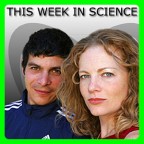Podcast: Play in new window | Download (Duration: 1:14:52 — 34.3MB)
TWIWRD!, Dirty Diesel, Warm Dinos, Lonesome George Memorial, Hurricanes And Standing, Germline Edits, You Carb Girl!, Nano-Drug Factories, Grass Eating Ancestors, Lab Photosynthesis, A Curious Mind, And Much More…
Disclaimer, Disclaimer, Disclaimer!!!
Despite everything you may have heard…
There is much more to the story than anyone has reported…
It doesn’t matter what story, on which subject or how carefully illustrated…
What does matter is that you fully appreciate that no matter what we know or how well we know it, there is always more knowing left unknown…
The level of complexity within any single point of data is by its nature a massive over simplification of a broader symphony of data points, each with their own complex ecology of factoids and on and on it goes…
A universe so complicated in its construction, yet so symmetrically simple in it conclusions…
A world of information, vast and infinite, flowing in every direction of time and scale
and yet decipherable to finite degrees and in the right hands… the information becomes a tool
a tool for building, curing and innovating the world around us…
that tool is our greatest accomplishment as a species and the main subject of conversation each week here on…
This Week in Science… coming up next
World Robot Domination and Machine learning!
A research team out of Google linked 16,000 processors and presented 10 million thumbnails from youtube to the “computer,” without giving it any directions for what to do with them. Naturally, it found and identified cats. In fact, they never told the computer what a cat was, but the computer “cat”egorized the felines in a group on it’s own. I can haz robot brain?
Diesel – not so clean after all
After analyzing soot particles of different origins, scientists discovered that particles from diesel exhaust leave around half of their brethren behind when you exhale. By contrast, only 20% of soot particles from wood fires stay in your body, as opposed to diesel’s 50%. Perhaps it isn’t a cleaner fuel after-all…
Blair’s Animal Corner – Extinct Edition!
Dinosaurs – they may have been warm blooded
We don’t know a lot about dinosaurs’ flesh and blood (and it’s temperature) but we know quite a bit about their bones. Dino bones show lines of arrested growth, or “Lags,” which previously we could only ever find in other ectotherms. In a recent study of mammal bones to see how they coped with past climate change, scientists stumbled upon a discovery – every mammal species they looked at had Lags on their bones. This throws the main point of argument for the cold-blooded nature of dinosaurs into question, leaving us to ask, were they actually warm-blooded?
And on a sad note, we said goodbye to Lonesome George this week:
Lonesome George, the last remaining Pinta island giant tortoise, passed away this past Sunday at over 100 years old. Lonesome George was discovered in 1972 when his subspecies was thought to already be extinct, and has since served as a spokes-turtle for endangered species everywhere. Even in his absence, he has made an impact – his death inspired an international workshop set to take place in July to help restore tortoise populations around the world. He will be missed.
Get a free audiobook at Audible.com!
Standing while pregnant – Dangerous!
Standing or working for long hours during pregnancy could stunt fetal growth, according to a new study. Working women had healthier babies, but need to take frequent breaks to take time to sit to prevent low birth weight. So, get back to work, pregnant moms, but don’t work too hard!
Also, hurricanes are bad for your baby
Mothers that were within 30 km of a hurricane within their third trimester of pregnancy had a spike in abnormal conditions in their newborns.
Editing the germline
The world’s first genetically modified babies have been born, over ten years ago, thanks to the Institute of Reproductive Medicine in New Jersey. Apparently, two babies so far have tested positive to contain genes from three parents.
Carbs bad? Maybe carbs good.
Low carb, high protein diets linked to heart disease in women. A study including more than 43,000 women indicated that though that fad diet might reduce your waistline, it might also reduce your life expectancy. So you decide.
Treating diseases with minute drug factories
Scientists have produced minute spheres that contain no drugs, but instead the building blocks and mechanisms to make the drug “in house.” This is a great step forward for drugs that are harmful to the human body on their way to their destination. They can go in inert, and then are triggered by a laser, at which point they kick into gear making the drug.
Australopithecus ate a lot of grass…
By looking at some teeth, Texas A & M researchers have discovered that Australopithecus may have lived in a more woody area than previously thought. They discovered this from their diet – these hominoids ate leaves, fruits, nuts, and bark, leading us to believe their environment was more of a forest than a grassland.
Photosynthesis recreated in the laboratory
Using nano wires, scientists have found a way to harness the energy of the sun, as in photosynthesis. Perhaps this new technology could be used for clean energy in our homes!
A curious mind
Jonathon Allen, a biochemistry major at UC Santa Cruz, heard about an interesting spike in carbon-14 in tree rings in 774 AD. Some goggling led him to a description of a “red crucifix” in the night sky around the same year. Further research led him to the conclusion that it was most likely a supernova – hooray for the curious undergrad!
If you love TWIS, please support us by donating below:



Great episode!
Nice energy and variety of topics.
Thanks for continuing.
http://arxiv.org/abs/1112.6209
7:55 they … let the computer learn what these things were
8:25 it was able to carve out categories, one of those was a cat
8:45 it basically invented the concept of a cat
Some neural networks are trained by Supervised Learning.
In this paradigm, the training set is like a set of flash cards.
It has the answer on the back of the card, so to speak.
Synapses that help produce the right answer are then strengthened.
But this neural network was trained by Unsupervised Learning.
In this paradigm, the training set does not say which pictures are of cats.
Instead, it aims to vary the behavior of each neuron, in hopes one will do well.
You see, the researchers knew what things they were looking for.
They searched for neurons that performed best at identifying cats, for example.
The neurons did not come labeled with these categories.
It took tons of computing power to test each neuron, in search of a high performer.
In this way, the researchers supplied the concept of cat to the neural network.
Not the other way around!!!
Still, the neural network was able to accommodate this concept quite well.
Out of a billion neurons, one of them matches cats with 74.8% accuracy.
That’s pretty cool.
But please, don’t let Dr. Dean fool you.
This neural network did not invent anything!
The algorithm that produced varied and useful neurons is the true invention.
12:00 This could be, secretly, a very huge step…
Justin, I know you love to make things sound more mysterious than they really are.
But please don’t be a blow-hard like Dr. Dean.
Really, this is no great advance in neural networks.
Unsupervised Learning has been around since 1999.
See: http://www.amazon.com/dp/026258168X
It is, however, another great algorithm from Google X labs.
Kirsten, I believe your interpretation of the Standing while pregnant story is very likely to be correct.
I would be curious to test for a link between other things, like high blood pressure and fetal development.
The carbs story should not have been aired on a Science show, let alone on one of the caliber and quality of TWIS, since neither the “study” nor its rediculously overstated “conclusions” can be considered actual science. Shame on BMJ for their editorial, for publishing such a horrendously flawed and ill-conducted “study”, and, it pains me to say, on TWIS for breaking a story based on mass media hyperbole without first validating the science worthiness of it. While the yahoos in the popular press can be expected to blurb unsupported claims based on non-science nonsense masquerading as science, I’ve grown accustomed to a higher level of story from TWIS. Great job in general, butthe please dont let silliness like this slip
through as if it had any ral scientific weight. Cheers to Science, and to TWIS for bringing it to the public, despite the occasional oversight. P.S. The journal Science investigative journalist Gary Taubes does a great job of describing the standards of non-science vs actual science in his many recent articles and especially in his 500+ page review of a century of nutrition science called “Good Calories Bad Calories”, which would be a great addition to the twis book of the month.
Jack,
Here’s the actual paper: http://www.bmj.com/content/344/bmj.e4026
The conclusion reads:
I read the entire paper, and see no flaw in the conclusion as stated.
For me, the important finding was on page 4:
The CNN Health blog, on the other hand, is typical journalistic garbage.
Obviously, the nature of carbohydrates and the source of proteins are hugely important!
Those just aren’t the thing being studied in this paper.
And it’s not a bad paper.
I’m betting that thing about carbs will turn out that the women on LCHF eat the wrong kinds of fats… When on LCHF you’re supposed to replace the carbs with fats to feel full more easily. In Sweden, where LCHF is the craze, there are sugar lobbied reports all the time about how dangerous it can be for the heart, but they’re always refuted with their data being more about the wrong kinds of fats than the low carbs or high proteins.
Marks Daily Apple gives a nice breakdown of some flaws with that study.
http://www.marksdailyapple.com/is-it-time-to-retire-the-low-carb-diet-fad/#axzz20uB2hvX8
Would love to hear you thoughts on their rebuttal to this study.
Great show keep up the good work.